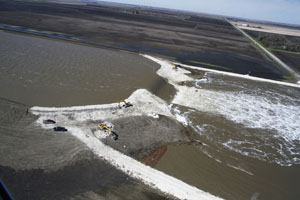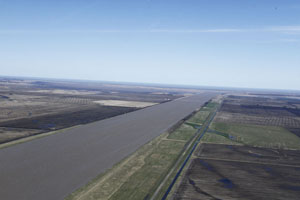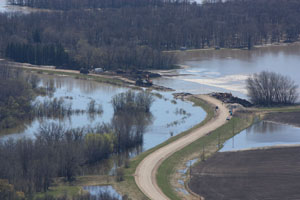2011 Flood
Flooding on the Assiniboine River
In 2011, many portions of the Assiniboine River Basin experienced record or near-record flooding. Above normal soil moisture at freeze-up, above normal winter snow pack as well as spring and summer precipitation, including severe storms, led to major flooding in much of the Assiniboine River Basin in both Manitoba and Saskatchewan.
Flooding on Lake Manitoba
Water levels on Lake Manitoba reached a record-high peak in late July of 2011 at 249.1 metres (817.2 feet) above sea level, more than 1.4 metres (4.7 feet) higher than the top of the desirable range of 810.5 to 812.5 feet. High water levels continued into the late fall, when water remained approximately 0.6 metres (2 feet) above the top of the desirable range. The unprecedented high levels were a result of numerous factors, including:
High water levels on Lake Manitoba in 2010 were due to above average precipitation in the fall of 2010. Outflows out of Lake Manitoba through the Fairford River Water Control Structure were kept at maximum except for three months in the winter when they were reduced to moderate Lake St. Martin water levels which, in turn, moderated flows on that lake's outlet, the Dauphin River. Moderating the river flows minimized the impact of frazil ice development which typically occurs with high flows on the river.
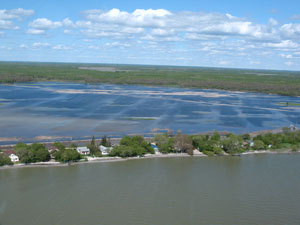 Aerial view of flooding at Lundar Beach, June 1, 2011 |
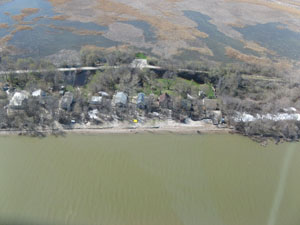 Aerial view of flooding at Delta Beach, May 17, 2011 |
Record high inflow volume from Lake Winnipegosis in 2011. The total volume of inflow from Lake Winnipegosis into Lake Manitoba in 2011 was the second highest ever recorded, second only to the record inflow volume in 2010.
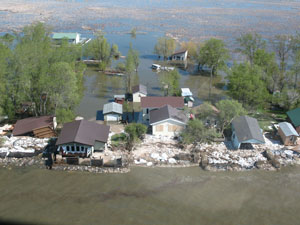
Aerial view of St. Laurent following the storm, June 1, 2011
Above average precipitation resulted in significant rainfall over the lake and surrounding watershed. This contributed to the high lake levels. The wind storms also caused real property damage around the lake. In particular, the storm between May 27 and June 1, resulted in waves as high as 2.1 metres (7 feet) hitting dikes and buildings. In addition to significant rainfall, on May 31 gale force winds (40 km/hr and higher) magnified the already destructive wave action, destroying or severely damaging many cottages and homes around Lake Manitoba.
High and prolonged usage of the Portage Diversion. Due to the unprecedented high flows on the Assiniboine River, a large volume of water was diverted from the Assiniboine River into Lake Manitoba via the Portage Diversion. Water was diverted from the Assiniboine River to Lake Manitoba for a period of 126 days. For 31 days the flow was in excess of the Diversion's design capacity of 707.9 cms (25,000 cfs). During operation in 2011, the Portage Diversion diverted a record volume of 4.73 million acre-feet (5.83 million dam3) of water into Lake Manitoba.
Levels on Lake Manitoba were lowered due to the following factors:
Positive Influence of the Fairford River Water Control Structure. When the Fairford River Water Control Structure (FRWCS) was built in 1961 the outlet channel was enlarged, increasing the potential outflow capacity out of Lake Manitoba by up to three times the natural outlet capacity. The increased outlet capacity was designed to help maintain more stable levels on Lake Manitoba. It also allowed for higher outflows to offset the additional inflows that would be diverted from the Assiniboine River once the Portage Diversion was put into operation. The increased outlet capacity also allows lake levels to be brought down more quickly when needed. This additional outflow capacity provided a significant flood reduction benefit to Lake Manitoba. For example, in the calendar year 2011, the total outflow volume recorded through the FRWCS was 10,514,000 acre-feet (13,000,000 dam3). The computed natural outflow volume through the Fairford River in the absence of the FRWCS would have been 7,014,000 acre-feet (8,650,000 dam3). Of note, these values only show the benefit that the FRWCS provided during the flood event; they do not include the beneficial reduction in water levels provided before and after the flood event. At the end of 2012, operation of the FRWCS helped bring lake levels down to 248.5 metres (812 feet), about 0.75 metres (2.5 feet) lower than what levels would have occurred in the absence of the FRWCS and Portage Diversion.
Prior to construction of the Fairford River Water Control Structure, Lake Manitoba exceeded the level 247.95 metres (813.5 feet) for four consecutive years, from 1954 to 1957, and it reached a peak of 248.79 metres (816.25 feet) in July of 1955 because of the limited outlet capacity. If the Fairford River Water Control Structure had not been built, lake water levels would have exceeded 247.95 metres (813.5 feet) for about six years in total between 1961 and 2011. However, the increased capacity of the structure kept water levels below 247.8 metres (813 feet) virtually the entire period.
Overflows from the Assiniboine River. The Portage Diversion channel generally follows low-lying land between Portage la Prairie and Lake Manitoba. Reports from the historic 1882 flood indicate that overflows from the Assiniboine River, from this location on the Assiniboine River, travelled north to Lake Manitoba at a depth of 2.13 metres (7 feet), contributing a considerable volume of water to Lake Manitoba. In 2011, flows in the Assiniboine River west of Portage la Prairie exceeded 622.97 cms (22,000 cfs) for 105 days. Under natural conditions, overflows from the Assiniboine River would have occurred during that period and a portion of those overflows would have reached Lake Manitoba and added to the already high natural levels that would have occurred in Lake Manitoba in the absence of all flood control works. Overflows from the Assiniboine River were prevented by a combination of the Assiniboine River dikes and operation of the Portage Diversion to limit flows on the lower Assiniboine River. The 2011 Flood: Technical Review of Lake Manitoba, Lake St. Martin and Assiniboine River Water Levels (2013) (PDF, 8.2 MB) report details historic overflows and expands on the flood conditions experienced in 2011.
Flooding on Lake St. Martin
Lake St Martin is susceptible to flooding due to the low-lying landscape surrounding the lake. Wet conditions in 2010 resulted in lake levels reaching a level of 244.1 metres (801 feet) in January 2011, above the historic average of 242.9 to 243.9 metres (797 to 800.5 feet). Lake levels rose above flood stage of 244.4 metres (801.7 feet) in March 2011. Lake St. Martin levels were further increased by record high spring flows on the Fairford River, resulting in a maximum level of 245.5 metres (805.6 feet), approximately 0.6 metres (2 feet) higher than the previous recorded maximum level. Areas around the lake were flooded and community residents were evacuated.
In some past high water events, frazil ice formed on the Dauphin River, the outlet from Lake St. Martin, constricting the channel and significantly reducing the river flow.
Frazil ice is soft or amorphous ice formed by the accumulation of ice crystals in water that is too turbulent to freeze solid.
If frazil ice were to develop on the Dauphin River in the fall or winter of 2011 it would have reduced outflow and further exacerbated flooding on Lake St. Martin. If Lake Manitoba outflows through the Fairford River Water Control Structure were reduced to ease the flooding on Lake St. Martin, the water levels on Lake Manitoba would also remain higher for a longer period of time. To address the existing flooding on both lakes and to avert further ice induced flooding over winter, it was determined that an emergency outlet channel was necessary to increase the total outflow from Lake St. Martin. On November 1, 2011, the Manitoba governent opened the Lake St. Martin Emergency Channel, increasing outflow from Lake St. Martin through Big Buffalo Creek. On November 18, water levels on Lake St. Martin had declined to a level of 244.8 metres (803.2 feet), down from the peak of 245.5 metres (805.5 feet).
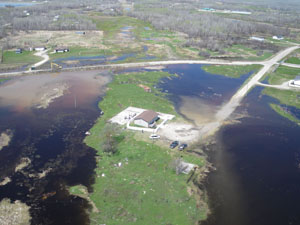 Lake St. Martin, May 17, 2011 |
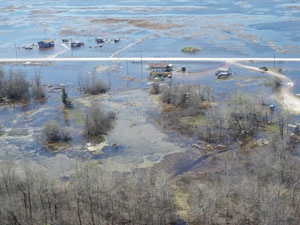 Lake St. Martin, May 17, 2011 |
Lake St. Martin is generally negatively affected by the regulation of Lake Manitoba through operation of the Fairford River Water Control Structure, with Lake St. Martin often suffering artificially high or low water levels depending on conditions on Lake Manitoba. For example, Lake St. Martin now experiences higher inflows (outflows from Lake Manitoba) during high water periods and lower lake levels due to reduced inflow (outflows from Lake Manitoba) during dry periods.
Flooding on Lake Winnipegosis and the Waterhen River
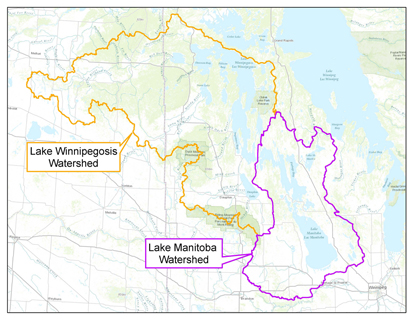 Lake Winnipegosis receives inflows from the north slopes of the Riding Mountains, the eastern and northern slopes of the Duck Mountains, the Porcupine Mountains and parts of eastern Saskatchewan. The outlet from Lake Winnipegosis is the Waterhen River, connecting Lake Winnipegosis to the north basin of Lake Manitoba. Lake Winnipegosis outflows are unregulated, so lake levels rise and fall with changing conditions.
Lake Winnipegosis receives inflows from the north slopes of the Riding Mountains, the eastern and northern slopes of the Duck Mountains, the Porcupine Mountains and parts of eastern Saskatchewan. The outlet from Lake Winnipegosis is the Waterhen River, connecting Lake Winnipegosis to the north basin of Lake Manitoba. Lake Winnipegosis outflows are unregulated, so lake levels rise and fall with changing conditions.
The lake level at the start of 2011 was unusually high because of high runoff in the fall of 2010. As a result, the lake reached a peak of 254.5 metres (835 feet) in late June. In 2011 Lake Winnipegosis had the highest summer levels observed since record keeping began in 1913. These high levels resulted in record high flows on the Waterhen River. Approximately 4.7 million acre-feet of water moved from Lake Winnipegosis to Lake Manitoba between April and August. High flows on the Waterhen River continued well into the winter, causing frazil ice on the Waterhen River.


